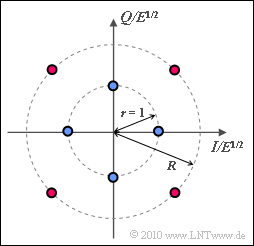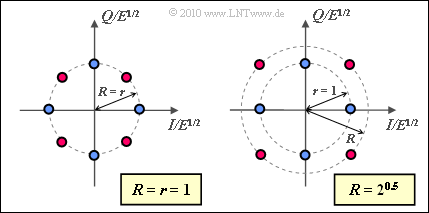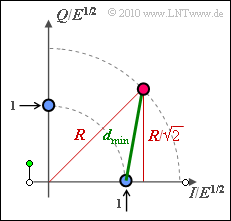Difference between revisions of "Aufgaben:Exercise 4.15: Optimal Signal Space Allocation"
| Line 1: | Line 1: | ||
| − | {{quiz-Header|Buchseite= | + | {{quiz-Header|Buchseite=Digital_Signal_Transmission/Carrier_Frequency_Systems_with_Coherent_Demodulation}} |
| − | [[File:P_ID2069__Dig_A_4_15.png|right|frame| | + | [[File:P_ID2069__Dig_A_4_15.png|right|frame|Considered 8–QAM]] |
| − | + | A signal space constellation with $M = 8$ signal space points is considered here: | |
| − | * | + | * Four points lie on a circle with radius $r = 1$. |
| − | * | + | * Four further points lie offset by $45^\circ$ on a second circle with radius $R$, where the following shall hold: |
:$$R_{\rm min} \le R \le R_{\rm max}\hspace{0.05cm},\hspace{0.2cm} R_{\rm min}= \frac{ \sqrt{3}-1}{ \sqrt{2}} \approx 0.518 | :$$R_{\rm min} \le R \le R_{\rm max}\hspace{0.05cm},\hspace{0.2cm} R_{\rm min}= \frac{ \sqrt{3}-1}{ \sqrt{2}} \approx 0.518 | ||
\hspace{0.05cm},\hspace{0.2cm} | \hspace{0.05cm},\hspace{0.2cm} | ||
R_{\rm max}= \frac{ \sqrt{3}+1}{ \sqrt{2}} \approx 1.932\hspace{0.05cm}.$$ | R_{\rm max}= \frac{ \sqrt{3}+1}{ \sqrt{2}} \approx 1.932\hspace{0.05cm}.$$ | ||
| − | + | Let the two axes (basis functions) be normalized respectively and denoted $I$ and $Q$ for simplicity. For further simplification, $E = 1$ can be set. | |
| − | + | In the question section, we speak of blue and red points. According to the diagram, the blue points lie on the circle with radius $r = 1$, the red points on the circle with radius $R$. The case $R = R_{\rm max}$ is drawn. | |
| − | + | The system parameter $R$ is to be determined in this exercise in such a way that the quotient | |
:$$\eta = \frac{ (d_{\rm min}/2)^2}{ E_{\rm B}} $$ | :$$\eta = \frac{ (d_{\rm min}/2)^2}{ E_{\rm B}} $$ | ||
| − | + | becomes maximum. $\eta$ is a measure for the quality of a modulation alphabet at given transmission energy per bit ("Power Efficiency"). It is calculated from | |
| − | * | + | * the minimum distance $d_{\rm min}$, and |
| − | * | + | * the bit energy $E_{\rm B}$. |
| − | + | It must be ensured that $d_{\rm min}^2$ and $E_{\rm B}$ are normalized in the same way, but this is already implicit in the exercise. | |
| Line 28: | Line 28: | ||
| − | '' | + | ''Notes:'' |
| − | * | + | * The exercise belongs to the chapter [[Digital_Signal_Transmission/Carrier_Frequency_Systems_with_Coherent_Demodulation|"Carrier Frequency Systems with Coherent Demodulation"]]. |
| − | * | + | * Reference is made in particular to the sections [[Digital_Signal_Transmission/Carrier_Frequency_Systems_with_Coherent_Demodulation#Quadrature_amplitude_modulation_.28M-QAM.29|"Quadrature amplitude modulation"]] and [[Digital_Signal_Transmission/Carrier_Frequency_Systems_with_Coherent_Demodulation#M.E2.80.93level_amplitude_shift_keying_.28M.E2.80.93ASK.29|"Multilevel phase modulation"]]. |
| − | === | + | ===Questions=== |
<quiz display=simple> | <quiz display=simple> | ||
{Berechnen Sie die mittlere Energie $E_{\rm B}$ pro Bit abhängig von $R$, insbesondere für $R = 1$ und $R = \sqrt{2}$. | {Berechnen Sie die mittlere Energie $E_{\rm B}$ pro Bit abhängig von $R$, insbesondere für $R = 1$ und $R = \sqrt{2}$. | ||
Revision as of 21:03, 15 August 2022
A signal space constellation with $M = 8$ signal space points is considered here:
- Four points lie on a circle with radius $r = 1$.
- Four further points lie offset by $45^\circ$ on a second circle with radius $R$, where the following shall hold:
- $$R_{\rm min} \le R \le R_{\rm max}\hspace{0.05cm},\hspace{0.2cm} R_{\rm min}= \frac{ \sqrt{3}-1}{ \sqrt{2}} \approx 0.518 \hspace{0.05cm},\hspace{0.2cm} R_{\rm max}= \frac{ \sqrt{3}+1}{ \sqrt{2}} \approx 1.932\hspace{0.05cm}.$$
Let the two axes (basis functions) be normalized respectively and denoted $I$ and $Q$ for simplicity. For further simplification, $E = 1$ can be set.
In the question section, we speak of blue and red points. According to the diagram, the blue points lie on the circle with radius $r = 1$, the red points on the circle with radius $R$. The case $R = R_{\rm max}$ is drawn.
The system parameter $R$ is to be determined in this exercise in such a way that the quotient
- $$\eta = \frac{ (d_{\rm min}/2)^2}{ E_{\rm B}} $$
becomes maximum. $\eta$ is a measure for the quality of a modulation alphabet at given transmission energy per bit ("Power Efficiency"). It is calculated from
- the minimum distance $d_{\rm min}$, and
- the bit energy $E_{\rm B}$.
It must be ensured that $d_{\rm min}^2$ and $E_{\rm B}$ are normalized in the same way, but this is already implicit in the exercise.
Notes:
- The exercise belongs to the chapter "Carrier Frequency Systems with Coherent Demodulation".
- Reference is made in particular to the sections "Quadrature amplitude modulation" and "Multilevel phase modulation".
Questions
Musterlösung
- $$E_{\rm S} = {1}/{8 } \cdot ( 4 \cdot r^2 + 4 \cdot R^2) = ({1 + R^2})/{2 } \hspace{0.3cm}\Rightarrow \hspace{0.3cm} E_{\rm B} = {E_{\rm S}}/{3} = ({1 + R^2})/{6} \hspace{0.05cm}.$$
Insbesondere gilt:
- Für $R = 1$ ergibt sich eine 8–PSK ⇒ $E_{\rm S} = 1$ und $E_{\rm B} \ \underline {= 0.333}$ (siehe linke Grafik).
- Die rechte Grafik gilt für $R = \sqrt{2}$. In diesem Fall ist $E_{\rm B} \ \underline {= 0.5}$.
Anzumerken ist, dass diese Energien eigentlich noch mit der Normierungsenergie $E$ zu multiplizieren sind.
(2) Alle Aussagen treffen zu:
- Im gezeichneten Beispiel auf dem Angabenblatt mit $R = R_{\rm max}$ ist der Abstand zwischen zwei benachbarten blauen Punkten genau so groß wie der Abstand zwischen einem roten (äußeren) und einem blauen (inneren) Punkt.
- Für $R > R_{\rm max}$ ist der Abstand zwischen zwei blauen Punkten am geringsten.
- Für $R < R_{\rm min}$ tritt der minimale Abstand zwischen zwei roten Punkten auf.
(3) Die Grafik verdeutlicht die geometrische Berechnung. Mit "Pythagoras" erhält man:
- $$d_{\rm min}^2 =(R/\sqrt{2})^2 + (R/\sqrt{2}-1)^2 = 1 - \sqrt{2} \cdot R + R^2 \hspace{0.3cm} \Rightarrow \hspace{0.3cm}d_{\rm min} = \sqrt{ 1 - \sqrt{2} \cdot R + R^2} \hspace{0.05cm}.$$
Insbesondere gilt für $R = 1$ (8–PSK):
- $$d_{\rm min} = \sqrt{ 2 - \sqrt{2} } \hspace{0.1cm} \underline{= 0.765} \hspace{0.1cm} (= 2 \cdot \sin (22.5^{\circ}) ) \hspace{0.05cm}.$$
Dagegen ist für $\underline {R = \sqrt{2}}$ entsprechend der rechten Grafik zur Teilaufgabe (1) die minimale Distanz $d_{\rm min} \ \underline {= 1}$.
(4) Mit den Ergebnissen von (1) und (3) erhält man allgemein bzw. für $R = 1$ (8–PSK):
- $$\eta = \frac{ d_{\rm min}^2}{ 4 \cdot E_{\rm B}} = \frac{ 1 - \sqrt{2} \cdot R + R^2}{ 4 \cdot (1 + R^2)/6} = \frac{ 3/2 \cdot(1 - \sqrt{2} \cdot R + R^2)}{ 1 + R^2}\hspace{0.3cm} \Rightarrow \hspace{0.3cm} R = 1: \hspace{0.2cm}\eta = \frac{ 3/2 \cdot(2 - \sqrt{2}) }{ 2} = 3/4 \cdot(2 - \sqrt{2})\hspace{0.1cm} \underline{\approx 0.439}\hspace{0.05cm}.$$
(5) Für $R = R_{\rm min} = (\sqrt{3}-1)/\sqrt{2}$ ergibt sich folgender Wert:
- $$\eta = \frac{ 3/2 \cdot(1 - \sqrt{2} \cdot R + R^2)}{ 1 + R^2} = 3/2 \cdot \left [ 1 - \frac{ \sqrt{2} \cdot R }{ 1 + R^2}\right ]\hspace{0.05cm},$$
- $$\sqrt{2} \cdot R = \sqrt{3}- 1\hspace{0.05cm},\hspace{0.2cm} 1 + R^2 = 3 - \sqrt{3} \hspace{0.3cm}\Rightarrow \hspace{0.3cm} \eta = 3/2 \cdot \left [ 1 - \frac{ \sqrt{3}- 1 }{ 3 - \sqrt{3}}\right ]\hspace{0.1cm} \underline{\approx 0.634}\hspace{0.05cm}.$$
Für $R = R_{\rm max}= (\sqrt{3}+1)/\sqrt{2}$ ergibt sich genau der gleiche Wert.
- Das (stets gewünschte) Maximum der Leistungseffizienz $\eta$ ergibt sich beispielsweise für $R = R_{\rm max}$ – also für die Signalraumkonstellation auf dem Angabenblatt.
- In diesem Fall sind alle Dreiecke aus zwei benachbarten blauen Punkten und dem dazwischenliegenden roten Punkt gleichseitig.
- Auch für $R = R_{\rm min}$ ergeben sich gleichseitige Dreiecke, jetzt aber jeweils gebildet durch zwei rotee und einen blauen Punkt.
- In diesem Fall ist zwar die Kantenlänge $d_{\rm min}$ deutlich kleiner, aber gleichzeitig ergibt sich auch ein kleineres $E_{\rm B}$, so dass die Leistungseffizienz $\eta$ den gleichen Wert besitzt.
Die vorher betrachteten Sonderfälle $R = 1$ (8–PSK, linke Grafik bei der ersten Teilaufgabe) und $R = \sqrt{2}$ (rechte Grafik) weisen mit $\eta = 0.439$ bzw. $\eta = 0.5$ (gegenüber $\eta = 0.634$) ein merklich kleineres $\eta$ auf.


